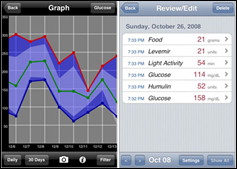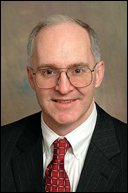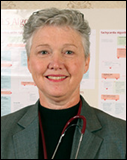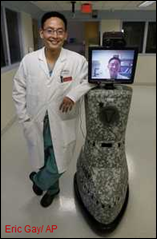News 9/01/09
From Dr. T: “Re: Practice Fusion. I was under the impression that Practice Fusion did not have patient-to-MD e-mail.” Back in February, Vatsal Thakkar, MD participated in an HIT Moment and said, “Practice Fusion says it is in their future plan to incorporate e-communications to/from patients that are HIPAA-compliant and/or encrypted. What I am currently using is an add-on from my MS Exchange hosting service called SecureMail. It simplifies the process for users of Outlook such that encrypting a message is a simple click which prompts you to enter the challenge question that the patient can answer to open the email and write back. It also informs you if the message was NOT opened by the end of 30 days (at which point it expires). The vendor is at www.intermedia.net.”
Speaking of Practice Fusion, it is offering free integration with Quest Diagnostics for lab results.
Greenway Medical announces its 11th consecutive fiscal year of positive growth, ending its 2009 fiscal year with a 38% increase in sales over 2008 and 88% over 2007. Ever since I can remember, Greenway competitors have loved to discuss how the privately help Greenway wouldn’t be able to make it long term, that they would run out of money and never turn a profit. While higher sales do not necessarily equate to increased profits (or any profits for that matter), but, you have to hand it to Greenway for its tenacity and continued growth. There are a lot of sunset companies out there that would have loved eleven years of positive growth.
We are indeed fortunate to have Medicity as a new Platinum Sponsor of HIStalk Practice. The company was the first sponsor of HIStalk many years ago and continues as a Founding Sponsor there, which we certainly appreciate. It in inspiring to see how the company has grown, both organically and via strategic acquisitions that include a gem of EHR interoperability technology, the former Novo Innovations (now the Medicity Novo Grid). Other offerings include the ProAccess Clinical Application Suite and MediTrust Clinical Interoperability Platform. Ten years after its founding by Chairman and CEO Kipp Lassetter MD, the company leads the market and will undoubtedly continue its leadership role in RHIO, HIE, and national health network projects (it’s offering a September 4 Webinar entitled Maximizing New ARRA-Funded Federal Grants for Health Information Exchanges).Thanks to Medicity for its continuing support of HIStalk and HIStalk Practice.
Greenway also introduces its new partnership with RelayHealth, giving PrimeSuite clients access to lab results, radiology reports, and transcribed documents from their community health system through Relayhealth’s Virtual Information Exchange.
Supermarket chain Harris Teeter (found mostly in the eastern US) implements a PHR to improve prescription accuracy in its pharmacies. An agreement with Connectyx Technologies Holdings Group gives customers the opportunity to obtain a MedFlash drive for their PHR information, including medication specifics.
Claims clearinghouse provider Navicure adds three South Carolina practices to its client roster.
Physicians who perceive quality problems in their practices are more likely to experience dissatisfaction, isolation, and stress. Doctors in practices that have implemented quality initiatives and evaluated their effectiveness where less likely to feel that way.
eClinicalWork partners with Correctional Medical Services (CMS) to provider EMR solutions to correctional facilities affiliated with CMS. ECW already provides EHR to Rikers Island in New York.
Speaking of ECW, co-founder Raj Dharampuriya is interviewed by India Knowledge @ Wharton. He mentions that the company has opened a Mumbai support center to handle US customers that run 24 hours a day, such as a prison. The company will hire 500 people in the next two years, most of them in implementation and support, and will open an office next month in San Francisco. He credits the Indian culture of the founders in helping them focus on their goal of building a business and changing the delivery of healthcare. He still practices medicine part time and says he’s in the top 10% of performers according to BCBS.
If you are feeling the need to get up to speed on the upcoming ICD-10 coding system, you can review the new fact sheet being offered by CMS. I was sure it was going to be something I could use to cure my insomnia, by it’s actually nicely laid out, provides an easy-to-read overview, and includes plenty of graphics.
The MGMA sends the CMS a 12-page letter, providing comments on the proposed 2010 Physician Fee Schedule. Topping the list: MGMA urges urges CMS to accelerate the use of reporting from EHRs for 2010 PQRI participation. MGMA also believes that groups of any size should be able to report on proposed measures, using a properly structured group practice reporting mechanism.
Three-provider Walker Family Medicine (AZ) selects OminMD for its EMR and practice management solutions.
CMS reports that almost all of the 610 small practice and solo physicians participating in a pay-for-performance demonstration project earned bonuses. The practices are being paid a total of $7.5 million for meeting quality standards through the use of HIT. The average payment was $14,000, with some practices earning as much as $62,500. To qualify, practices had to show their use of HIT improved the quality of care for patients with chronic conditions.
A local paper reports that Outer Cape Health Services (MA) has had a “mass resignation at the senior level staff level” as a result of management reorganizations and cost-cutting measures. The article is published in The Wicked Local, which I envision as of of those freebie newspapers you pick up in the local coffee shop, the kind that includes a listing of what bands are playing at which pubs, and a wide assortment of personals that cover every conceivable dating choice. Anyway, the rather lengthy article places most of the blame for staff resignations and turnover on the health clinic’s new CEO, who took over the financially struggling practice in January. A disgruntled staffer says the new CEO put morale “in the toilet.” Another says she “humiliates people who don’t agree with her.” Essentially, they all but call her “wicked.” It may not be a Pulitzer Prize-winning piece of journalism, but it’s certainly more juicy than anything in the NY Times.

















The article about Pediatric Associates in CA has a nugget with a potentially outsized impact: the implication that VFC vaccines…